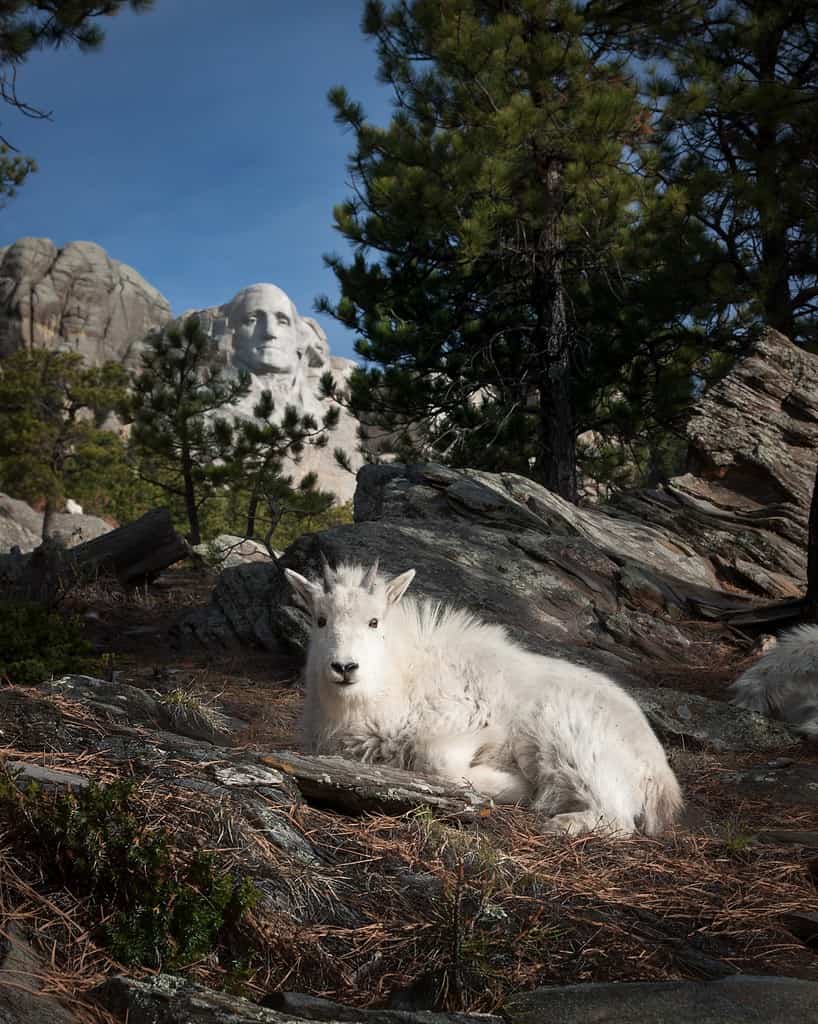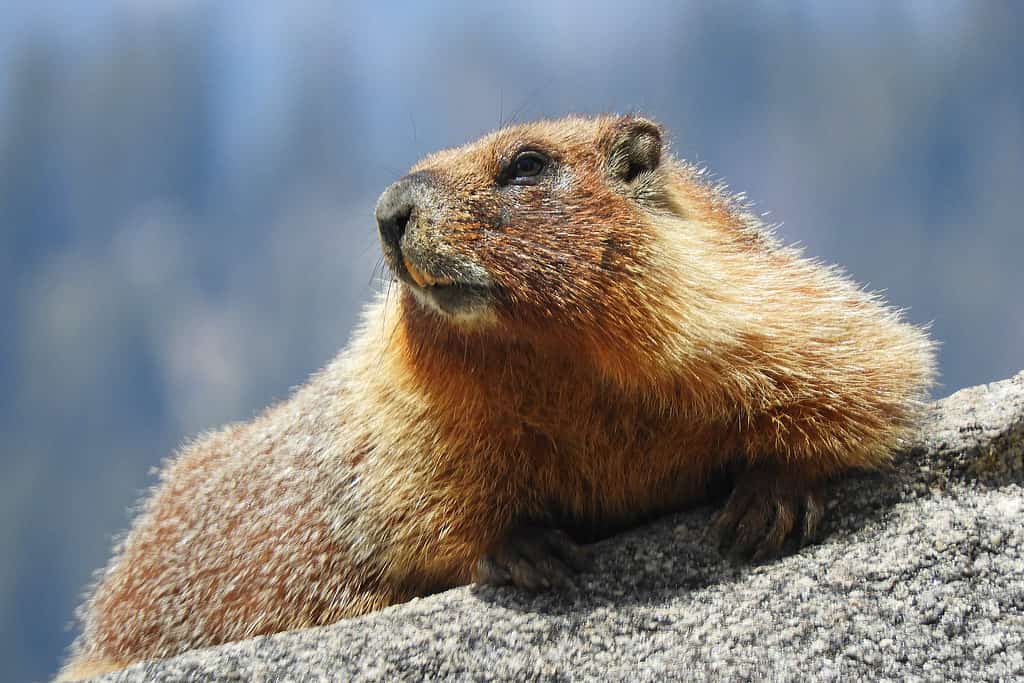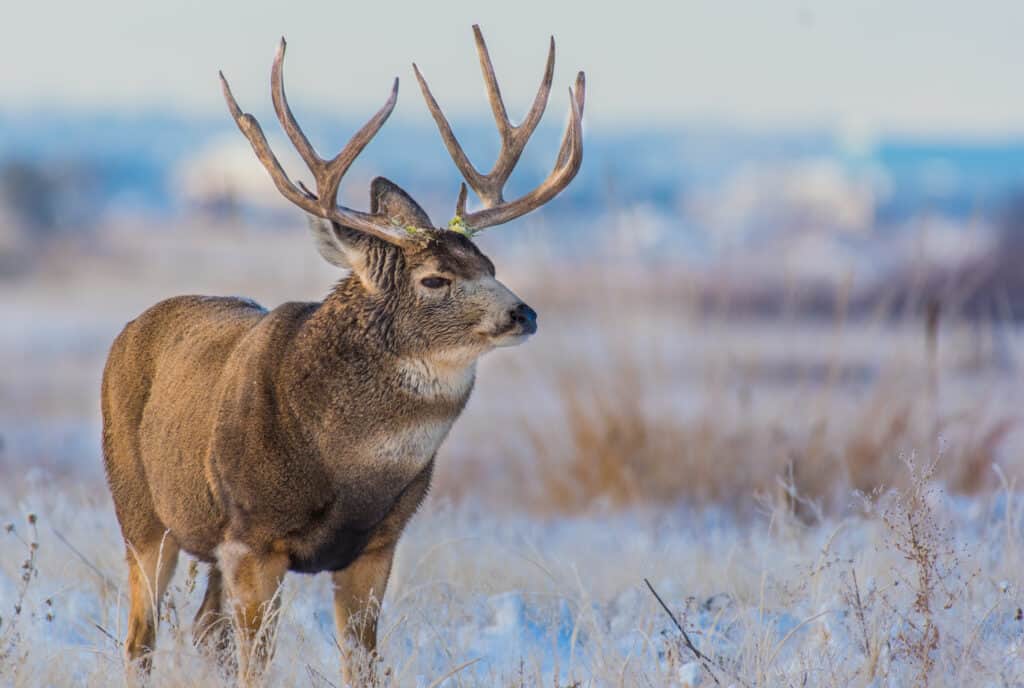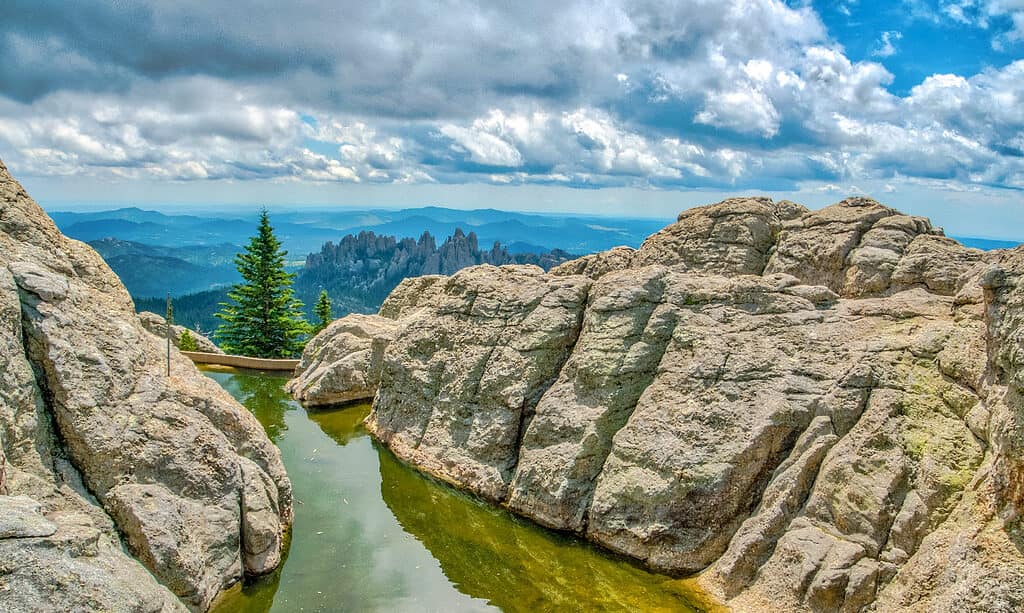Mount Rushmore National Memorial is an iconic American monument nestled in the beautiful Black Hills of South Dakota. The faces of George Washington, Thomas Jefferson, Theodore Roosevelt, and Abraham Lincoln are carved in the Harney Peak granite of the mountain. The faces of these four U.S. presidents are around 60 feet tall. George Washington’s nose alone measures 21 feet! Each eye on these presidential faces is about 11 feet wide, and each mouth is 18 feet wide.

Construction of Mount Rushmore was long, hard, and very dangerous, as seen in this photo from 1937.
©Everett Collection/Shutterstock.com
Creating Art Out of a Mountainside
Close to 400 workers contributed to the construction of this colossal piece of art in the middle of the South Dakota wilderness. The workers endured sweltering heat in the summer and the biting cold of South Dakota’s winter. Every day, they would climb 700 stairs to the top of the mountain to begin work. Steel cables lowered them down the face of the mountain in a “bosun chair.” It was hard and very dangerous work, but it was also the height of the Great Depression. Any job was a good job. Work on Mount Rushmore began on October 4, 1927, and was not completed until October 31, 1941.
Mount Rushmore is a symbol of American ambition, ingenuity, and achievement. But a visit to the Mount Rushmore National Memorial in South Dakota is a fascinating mesh of this manmade wonder in the middle of an amazing natural setting. Animals are plentiful in and around the National Memorial. Here are a few incredible native animals that you may see on your next visit to see “The Faces.”

1. Rocky Mountain Goat
Despite its name, the Rocky Mountain goat (Oreamnos americanus) is not a true goat. It is the only genus and species of its kind on earth. The closest relatives to the Rocky Mountain goat are the chamois of Europe and the goral and serow of Asia. The Rocky Mountain goat )or simply mountain goat) lives only in the west/northwestern part of North America.
This creature is a breathtaking climber. The Rocky Mountain goat has cloven hooves. Because they have two separate toes on each foot, mountain goats can get a solid grip on the rocks and ledges of their habitat, including the Black Hills of South Dakota. Their hooves are also very soft on the bottom, allowing them extra traction to climb very steep terrain.
Rocky Mountain goats feature long, white, shaggy coats that help keep them warm on mountain peaks and during the harsh winter conditions of their range. Their white coats are offset by their black horns, noses, and hooves.
The Rocky Mountain goats residing in the Black Hills all descend from six goats gifted to Custer State Park from Canada in 1924. These mountain goats escaped their enclosures and made a home in the granite peaks of the Black Hills. There are more than 200 mountain goats in the region today. They show up around the Mount Rushmore National Memorial.

Check out the cute face of this young Rocky Mountain goat with George Washington’s huge face in the background.
©Dennis Laughlin/Shutterstock.com
2. Mountain Lion
While the likelihood of seeing a mountain lion (Felis concolor) during your visit to Mount Rushmore National Memorial is low, the cats are certainly there. These elusive predators stalk the Black Hills of South Dakota, mostly hunting at night.
The mountain lion is also known as the puma, cougar, catamount, panther, and mountain screamer. The cat’s historic range included virtually the entire continental United States. In the 19th and early 20th centuries, the cat was hunted to near extinction in the eastern part of the country. This was largely due to farmers who were tired of the cats preying on their livestock.
Today, there are only 15 states that have documented populations of mountain lions. The list includes South Dakota. However, the population of mountain lions in Mount Rushmore State is smaller than that of other western states. This makes it even more unlikely that you will encounter one of these big cats while visiting the National Memorial.
Deer are the primary prey for the mountain lion. Mule deer are plentiful around Mount Rushmore, as will be discussed below. Access to prey, along with conservation efforts, may mean that mountain lions could one day proliferate the South Dakota landscape again.

They aren’t often seen, but mountain lions reside in the Black Hills around Mount Rushmore.
©Warren Metcalf/Shutterstock.com
3. Yellow-Bellied Marmot
The yellow-bellied marmot (Marmota flaviventris) is a large rodent that lives in the Rocky Mountains, Sierra Nevada, Black Hills, and other locations in the American West. At Mount Rushmore, yellow-bellied marmots are commonly seen along the Presidential Trail during the summer. Marmots hibernate from late October until late April.
Marmots feed on seeds, flowers, grasses, nuts, and broad-leaf plants. They spend most of their time during the summer foraging for food. Marmots must pack on as much body fat as possible to sustain them through their long winter hibernation.
Yellow-bellied marmots have few natural defenses, which means they have many natural predators. The marmot is a dietary mainstay for predators such as coyotes, foxes, raptors, bobcats, wolves, bears, and many others.
Because of the constant danger from predators, one marmot will stand guard over the colony while the rest of the marmots forage for food. If the guard spots a predator, it will whistle, and the marmot colony will scurry into underground burrows. This behavior led to the animal’s colloquial name, “whistle pig,’ even though it is not related to pigs. The marmot’s closest relatives are ground squirrels and prairie dogs.

Yellow-bellied marmots are often seen around Mount Rushmore and throughout South Dakota’s Black Hills.
©AustralianCamera/Shutterstock.com
4. Mule Deer
As noted early, mule deer (Odocoileus hemionus) are some of the most common animals around Mount Rushmore.
Mule deer are so-named because their large ears resemble those of a mule. These deer are closely related to white-tailed and black-tailed deer. Mule deer are the largest of the three. While it’s not common, these three types of deer can crossbreed.
Mule deer are known as ‘The Deer of the West.’ If you imagine a line drawn from North Dakota to Texas, mule deer inhabit every state that lies west of that line. The mule deer is an icon of western North America.
Mule deer, or “mulies” as they are sometimes called, can be observed at Mount Rushmore during the morning and evening in the summer. During the winter, they become more active during the warmth of midday.
Mule deer populations are healthy, and the deer is a popular game animal for hunters. (Hunting is not permitted at Mount Rushmore National Memorial, though!) Along with human hunters, mule deer are a critical prey animal for mountain lions, coyotes, wolves, bobcats, and bears.

Mule deer are common throughout the Black Hills.
©iStock.com/Kerry Hargrove
The Wonders of the Black Hills
The Black Hills of South Dakota are a natural wonder. The “black” reference alludes to the appearance of the hills from a distance. From miles away, the hills really do have a black hue. The wildlife in these hills is varied and spectacular.
More than two million people visit the Mount Rushmore National Memorial in the Black Hills each year. The sight of the huge faces of four U.S. presidents is amazing, but visitors to the National Memorial are also surrounded by natural flora and fauna that is equally awe-inspiring. Keep an eye out for these animals on your next visit to Mount Rushmore and the Black Hills.

Custer State Park is a treasure of the Black Hills. It’s also where the Mount Rushmore mountain goats originally came from.
©Exploring and Living/Shutterstock.com
Summary of the 4 Incredible Animals Roaming Mount Rushmore
| Rank | Animal |
|---|---|
| 1 | Rocky Mountain Goat |
| 2 | Mountain Lion |
| 3 | Yellow-Bellied Marmot |
| 4 | Mule Deer |
The photo featured at the top of this post is © Mendenhall Olga/Shutterstock.com
Thank you for reading! Have some feedback for us? Contact the AZ Animals editorial team.






